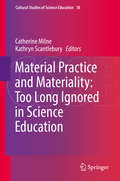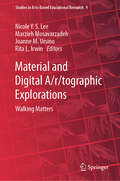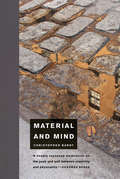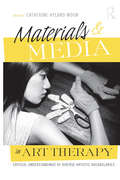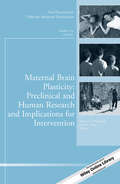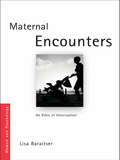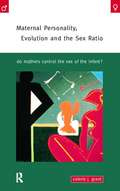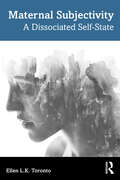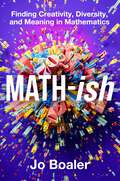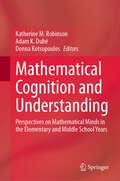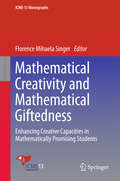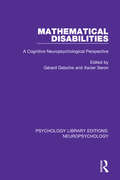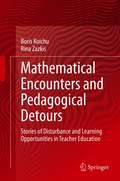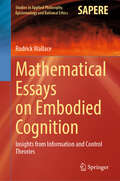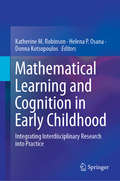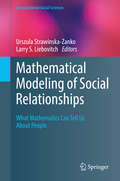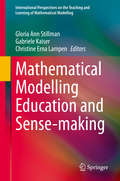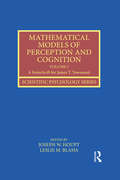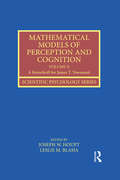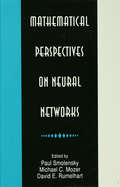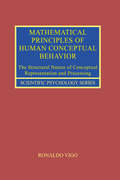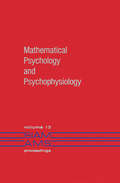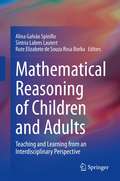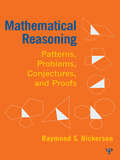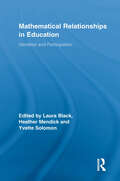- Table View
- List View
Material Practice and Materiality: Too Long Ignored in Science Education (Cultural Studies of Science Education #18)
by Kathryn Scantlebury Catherine MilneIn this book various scholars explore the material in science and science education and its role in scientific practice, such as those practices that are key to the curriculum focuses of science education programs in a number of countries.As a construct, culture can be understood as material and social practice. This definition is useful for informing researchers' nuanced explorations of the nature of science and inclusive decisions about the practice of science education (Sewell, 1999). As fields of material social practice and worlds of meaning, cultures are contradictory, contested, and weakly bounded. The notion of culture as material social practices leads researchers to accept that material practice is as important as conceptual development (social practice).However, in education and science education there is a tendency to ignore material practice and to focus on social practice with language as the arbiter of such social practice. Often material practice, such as those associated with scientific instruments and other apparatus, is ignored with instruments understood as "inscription devices", conduits for language rather than sources of material culture in which scientists share “material other than words” (Baird, 2004, p. 7) when they communicate new knowledge and realities. While we do not ignore the role of language in science, we agree with Barad (2003) that perhaps language has too much power and with that power there seems a concomitant loss of interest in exploring how matter and machines (instruments) contribute to both ontology and epistemology in science and science education.
Material and Digital A/r/tographic Explorations: Walking Matters (Studies in Arts-Based Educational Research #9)
by Rita L. Irwin Nicole Y. S. Lee Joanne M. Ursino Marzieh MosavarzadehThis book considers the generative tension between the materiality and virtuality of walking methodologies in a/r/tography and arts-based educational research. It explores the materiality of practice—manifestations, manipulations, residues, and traces of both real and imagined experiences and events. Authors present artistic representations, renderings, artifacts, and documentations that allow for various forms of return and re-visitation of places/spaces and temporal moments. The book also investigates the digital and virtual, including video, images, media work, and emergent technologies that allow one to literally, metaphorically, affectively, and conceptually go somewhere that might be previously impossible to reach. Authors consider curricular and pedagogical implications of digital/virtual walking in relation to desire, agency, autonomy, freedom, and other issues around ethics.The book brings together entanglements of the corporeal and incorporeal, addressing thequestions: How does the (im)materiality of bodies/characters-in-motion in a/r/tographic practices shape understandings of place, space, and the self-in-relation? How do issues and particularities come to matter through one’s entanglements with(in) the (in)corporeal?
Material and Mind
by Christopher BardtAn in-depth exploration of the interaction between mind and material world, mediated by language, image, and making—in design, the arts, culture, and science. In Material and Mind, Christopher Bardt delves deeply into the interaction of mind and material world, mediated by language, image, and the process of making. He examines thought not as something “pure” and autonomous but as emerging from working with material, and he identifies this as the source of imagination and creative insight. This takes place as much in such disciplines as cognitive science, anthropology, and poetry as it does in the more obvious painting, sculpture, and design. In some fields, the medium of work is, in fact, the very medium of thinking—as fabric is for the tailor. Drawing on the philosophical notions of the “extended mind” and the “enactive mind,” and looking beyond the world of material-based arts, Bardt investigates the realms in which material and mind interweave through metaphor, representation, projection, analogues, tools, and models. He considers words and their material origins and discusses the paradox of representation. He draws on the design process, scientific discovery, and cultural practice, among others things, to understand the dynamics of human thinking, to illuminate some of the ways we work with materials and use tools, and to demonstrate how our world continues to shape us as we shape it. Finally, he considers the seamless “immaterial” flow of imagery, text, and data and considers the place of material engagement in a digital storm.
Materials & Media in Art Therapy: Critical Understandings of Diverse Artistic Vocabularies
by Catherine Hyland MoonIn art making, materials and media are the intermediaries between private ideas, thoughts and feelings, and their external manifestation in a tangible, sensual form. Thus, materials provide the core components of the exchange that occurs between art therapists and clients. This book focuses on the sensory-based, tangible vocabulary of materials and media and its relevance to art therapy. It provides a historical account of the theory and use of materials and media in art therapy, as well as an examination of the interface between art therapy, contemporary art materials and practices, and social/critical theory. Contributing authors provide examples of how art therapists have transgressed conventional material boundaries and expanded both thinking and practice in the field. The chapters discuss traditional as well as innovative media, such as body adornments, mail and video art, and comic books. An accompanying DVD contains media clips, as well as 69 color images.
Maternal Brain Plasticity: New Directions for Child and Adolescent Development, Number 153 (J-B CAD Single Issue Child & Adolescent Development)
by Elena L. GrigorenkoThe transition to motherhood is marked by significant change at both biological and psychological levels, facilitating the development of maternal behavior. Interdisciplinary research converge to highlight the plasticity of the maternal brain, and the interplay of neurophysiology and postpartum experience, in shaping maternal brain and behavior. In this issue, new directions on the topic of the plasticity of the maternal brain is discussed by internationally renowned experts. Taking a lifespan developmental and crossspecies perspective, it highlights biological and environmental influences, including neuroendocrine events around parturition and offspring interactions, in shaping maternal brain plasticity. This issue highlights the importance of maternal periods of neural plasticity as optimal temporal windows for targeted interventions in families to foster maternal behavior and child development. This provides a unique opportunity to synergistically bring together research scientists with clinical teams that routinely work with mothers and their children to support and prosper the dyadic relationship through innovative translational research programs. This is the 153rd volume in this Jossey-Bass series New Directions for Child and Adolescent Development. Its mission is to provide scientific and scholarly presentations on cutting edge issues and concepts in this subject area. Each volume focuses on a specific new direction or research topic and is edited by experts from that field.
Maternal Encounters: The Ethics of Interruption (Women and Psychology)
by Lisa BaraitserWinner of the 2009 Feminist & Women's Studies Association (UK & Ireland) Book Award! Many women find mothering a shocking experience in terms of the extremity of feelings it provokes, and the profound changes it seems to prompt in identity, relationship and sense of self. However, although motherhood can catapult us into a state of internal disarray, it can also provide us with a unique chance to make ourselves anew. How then do we understand this radical potential for transformation within maternal experience? In Maternal Encounters, Lisa Baraitser takes up this question through the analysis of a series of maternal anecdotes, charting key destabilizing moments in the life of just one mother, and using these to discuss many questions that have remained resistant to theoretical analysis – the possibility for a specific feminine-maternal subjectivity, relationality and reciprocity, ethics and otherness. Working across contemporary philosophies of feminist ethics, as well as psychoanalysis and social theory, the maternal subject, in Baraitser’s account, becomes an emblematic and enigmatic formation of a subjectivity ‘called into being’ through a relation to another she comes to name and claim as her child. As she navigates through the peculiarity of maternal experience, Baraitser takes us on a journey in which ‘the mother’ emerges in the most unlikely, precarious and unstable of places as a subject of alterity, transformation, interruption, heightened sentience, viscosity, encumberment and love. This book presents a major new theory of maternal subjectivity, and an innovative and accessible way into our understanding of contemporary motherhood. As such, it will be of interest to students of family studies, gender studies, psychoanalysis, critical psychology and feminist philosophy as well as counselling and psychotherapy.
Maternal Personality, Evolution and the Sex Ratio: Do Mothers Control the Sex of the Infant?
by Valerie J. GrantWomen who are dominant are more likely to have sons. Demographic studies show that more male children are born after wars, yet most people believe that their baby's sex is a matter of chance - determined by the father's sperm. Valerie Grant presents evidence that the mother's personality - which is related to female testosterone levels - can actually influence which type of sperm fertilises the egg.Using data from human and animal studies Valerie Grant discusses the implications for human evolution, developmental psychology and reproductive biology. Her claims are controversial and the implications of her findings far reaching. Whether mothers have sons or daughters may not be a matter of chance. It may depend on which sex infant the mother is more suited to raise.
Maternal Subjectivity: A Dissociated Self-State
by Ellen L.K. TorontoIn this book, Ellen Toronto reveals the dissociation of maternal subjectivity from human experience and provides a psychoanalytic exploration of the (non-)history of motherhood to make possible an understanding and appreciation of maternal worlds. The persistent patriarchal order acknowledges the mother’s existence largely as a ‘womb’, a bearer of children, and although her role is essential in the service of the species, we know very little of her story as a person. The absent presence of the mother as an individual subject and collective ignorance about her experiences has constituted an existential trauma, that is, a trauma of non-existence, and it is only by revealing this dissociation, Toronto argues, that we can begin to excavate the stories of individual mothers as they have borne and raised the world’s children, and at last realise that the burdens they carry belong to us all. As a fulsome account of the maternal perspective, which draws from a variety of sources - including historical research, mythological stories and clinical case material – this book will be significant for students of psychoanalysis, feminism and history, as well as psychoanalysts in training and in practice who seek a richer understanding of maternal being.
Math-ish: Finding Creativity, Diversity, and Meaning in Mathematics
by Jo BoalerFrom Stanford professor, author of Limitless Mind, youcubed.org founder, and leading expert in the field of mathematics education Jo Boaler comes a groundbreaking guide to finding joy and understanding by adopting a diverse approach to learning math.“Every once in a while, someone revolutionizes an approach to a difficult subject and changes it forever. That is what Jo Boaler has done for math. Fresh, smart, and inclusive, Jo Boaler's strategy eschews the one-size-fits-a-few approach and instead allows math to be seen and solved by everyone. A huge achievement. Math-ish is the only math book I’ve ever enjoyed reading in my entire life. Honestly.” -Bonnie Garmus, author of Lessons in ChemistryMathematics is a fundamental part of life, yet every one of us has a unique relationship with learning and understanding the subject. Working with numbers may inspire confidence in our abilities or provoke anxiety and trepidation. Stanford researcher, mathematics education professor, and the leading expert on math learning Dr. Jo Boaler argues that our differences are the key to unlocking our greatest mathematics potential.In Math-ish, Boaler shares new neuroscientific research on how embracing the concept of “math-ish”—a theory of mathematics as it exists in the real world—changes the way we think about mathematics, data, and ourselves. When we can see the value of diversity among people and multi-faceted approaches to learning math, we are free to truly flourish. Utilizing the latest research on math education, Jo guides us through seven principles that can radically reframe our relationship with the subject:• The power of mindset on learning• Utilizing a visual approach to math• The impact of physical movement and communication on understanding• Understanding the value of an "ish" perspective - in mathematics and beyond• The importance of connected and flexible knowledge• New data on diverse teaching modes that work with different learning styles, not against them• The value of diversity in learning mathematics—and beyondWhen mathematics is approached more broadly, inclusively, and with a greater sense of wonder and play—when we value the different ways people see, approach, and understand it—we empower ourselves and gain a beneficial understanding of its value in our lives.
Mathematical Cognition and Understanding: Perspectives on Mathematical Minds in the Elementary and Middle School Years
by Katherine M. Robinson Donna Kotsopoulos Adam K. DubéThis book focuses on elementary and middle school children’s understanding of mathematics as well as the cognitive aspects involved in the development of mathematical knowledge, skills, and understanding. Children’s success in and understanding of mathematics stem from factors beyond the mathematics curriculum. Researchers are increasingly becoming aware of the necessity to consider a complex set of variables when accounting for large individual differences in mathematics achievement. These chapters contribute to how both researchers and educators can consider the multidimensionality of skills involved in developing mathematical knowledge in the middle school years as well as to how this knowledge can be used to enhance practices in the mathematics classroom. Topics include the cognitive and spatial skills involved in mathematics knowledge, the role of motivation in mathematics learning, the neurological processes and development of children’s mathematics skills, the development of understanding of arithmetic and fraction concepts, the factors relating to children’s word problem success, and techniques to promote mathematics understanding. This book and its companion, Mathematical Teaching and Learning, take an interdisciplinary perspective to mathematical learning and development in the elementary and middle school years. The authors and perspectives in this book draw from education, neuroscience, developmental psychology, and cognitive psychology. The book will be relevant to scholars/educators in the field of mathematics education and also those in childhood development and cognition. Each chapter also includes practical tips and implications for parents as well as for educators and researchers.
Mathematical Creativity and Mathematical Giftedness: Enhancing Creative Capacities In Mathematically Promising Students (ICME-13 Monographs)
by Florence Mihaela SingerThis book discusses the relationships between mathematical creativity and mathematical giftedness. It gathers the results of a literature review comprising all papers addressing mathematical creativity and giftedness presented at the International Congress on Mathematical Education (ICME) conferences since 2000. How can mathematical creativity contribute to children’s balanced development? What are the characteristics of mathematical giftedness in early ages? What about these characteristics at university level? What teaching strategies can enhance creative learning? How can young children’s mathematical promise be preserved and cultivated, preparing them for a variety of professions? These are some of the questions addressed by this book. The book offers, among others: analyses of substantial learning environments that promote creativity in mathematics lessons; discussions of a variety of strategies for posing and solving problems; investigations of students’ progress throughout their schooling; and examinations of technological tools and virtual resources meant to enhance learning with understanding. Multiple perspectives in the interdisciplinary fields of mathematical creativity and giftedness are developed to offer a springboard for further research. The theoretical and empirical studies included in the book offer a valuable resource for researchers, as well as for teachers of gifted students in specialized or inclusive settings, at various levels of education.
Mathematical Disabilities: A Cognitive Neuropsychological Perspective (Psychology Library Editions: Neuropsychology #5)
by Xavier Seron GÉrard DelocheOriginally published in 1987, interest in mathematical cognition was not new in psychology. However, it was rediscovered in the 1970s under the influential work of the Genevan School. In particular, Piaget’s work on conservation, including conservation of number, profoundly influenced developmental psychologists who, working first in the Piagetian theoretical framework, began to discover a broader set of topics in mathematical cognition. In developmental psychology, the field continued to expand and covered a wide range of topics. During the same period, however, no such evolution occurred in neuropsychology, and except for some studies around the time of publication, very little had been published on acalculia and number processing disorders. However, a more general theoretical evolution occurred in neuropsychology, mainly due to increasing collaboration between clinical and experimental neuropsychologists, on the one hand and cognitive psychologists on the other. The objective of this book was to promote an evolution in the neuropsychology of calculation and number processing deficits and thus to introduce clinical and experimental neuropsychologists, as well as developmental and cognitive psychologists, to recent research and theoretical approaches that are of particular interest for the neuropsychological approach to mathematical cognition.
Mathematical Encounters and Pedagogical Detours: Stories of Disturbance and Learning Opportunities in Teacher Education
by Rina Zazkis Boris KoichuThis book explores the idea that mathematics educators and teachers are also problem solvers and learners, and as such they constantly experience mathematical and pedagogical disturbances. Accordingly, many original tasks and learning activities are results of personal mathematical and pedagogical disturbances of their designers, who then transpose these disturbances into learning opportunities for their students. This learning-transposition process is a cornerstone of mathematics teacher education as a lived, developing enterprise. Mathematical Encounters and Pedagogical Detours unfold the process and illustrate it by various examples. The book engages readers in original tasks, shares the results of task implementation and describes how these results inform the development of new tasks, which often intertwine mathematics and pedagogy. Most importantly, the book includes a dialogue between the authors based on the stories of their own learning, which triggers continuous exploration of learning opportunities for their students.
Mathematical Essays on Embodied Cognition: Insights from Information and Control Theories (Studies in Applied Philosophy, Epistemology and Rational Ethics #72)
by Rodrick WallaceThis book provides a unique formal foundation for the development of statistical tools useful in the exploration of observational and experimental data related to embodied cognition. The asymptotic limit theorems of information and control theories can be used to construct statistical tools analogous to -- but different from -- regression models for the study of the often highly punctuated cognitive phenomena embedded in and hence influenced by a surrounding ecosystem of which the phenomena are themselves part. The book builds probability models based on those theorems that incorporate embodiment at a number of scales and levels of organization, ranging from the effects of stress on the immune system within a higher organism, through institutional (and machine) cognition under challenge from adversaries, to the failure of public health institutions under pathogen challenge. In distinct contrast to the existing literature, many detailed, worked-out examples provide templates for sophisticated readers to build their own model/tool constructs.
Mathematical Learning and Cognition in Early Childhood: Integrating Interdisciplinary Research into Practice
by Katherine M. Robinson Helena P. Osana Donna KotsopoulosThis book explores mathematical learning and cognition in early childhood from interdisciplinary perspectives, including developmental psychology, neuroscience, cognitive psychology, and education. It examines how infants and young children develop numerical and mathematical skills, why some children struggle to acquire basic abilities, and how parents, caregivers, and early childhood educators can promote early mathematical development. The first section of the book focuses on infancy and toddlerhood with a particular emphasis on the home environment and how parents can foster early mathematical skills to prepare their children for formal schooling. The second section examines topics in preschool and kindergarten, such as the development of counting procedures and principles, the use of mathematics manipulatives in instruction, and the impacts of early intervention. The final part of the book focuses on particular instructional approaches in the elementary school years, such as different additive concepts, schema-based instruction, and methods of division. Chapters analyze the ways children learn to think about, work with, and master the language of mathematical concepts, as well as provide effective approaches to screening and intervention.Included among the topics:The relationship between early gender differences and future mathematical learning and participation.The connection between mathematical and computational thinking.Patterning abilities in young children.Supporting children with learning difficulties and intellectual disabilities.The effectiveness of tablets as elementary mathematics education tools. Mathematical Learning and Cognition in Early Childhood is an essential resource for researchers, graduate students, and professionals in infancy and early childhood development, child and school psychology, neuroscience, mathematics education, educational psychology, and social work.
Mathematical Modeling of Social Relationships: What Mathematics Can Tell Us About People (Computational Social Sciences)
by Larry S. Liebovitch Urszula Strawinska-ZankoThis edited volume presents examples of social science research projects that employ new methods of quantitative analysis and mathematical modeling of social processes. This book presents the fascinating areas of empirical and theoretical investigations that use formal mathematics in a way that is accessible for individuals lacking extensive expertise but still desiring to expand their scope of research methodology and add to their data analysis toolbox. Mathematical Modeling of Social Relationships professes how mathematical modeling can help us understand the fundamental, compelling, and yet sometimes complicated concepts that arise in the social sciences. This volume will appeal to upper-level students and researchers in a broad area of fields within the social sciences, as well as the disciplines of social psychology, complex systems, and applied mathematics.
Mathematical Modelling Education and Sense-making (International Perspectives on the Teaching and Learning of Mathematical Modelling)
by Gabriele Kaiser Gloria Ann Stillman Christine Erna LampenThis volume documents on-going research and theorising in the sub-field of mathematics education devoted to the teaching and learning of mathematical modelling and applications. Mathematical modelling provides a way of conceiving and resolving problems in people’s everyday lives as well as sophisticated new problems for society at large. Mathematical modelling and real world applications are considered as having potential for cultivating sense making in classroom settings. This book focuses on the educational perspective, researching the complexities encountered in effective teaching and learning of real world modelling and applications for sense making is only beginning. All authors of this volume are members of the International Community of Teachers of Mathematical Modelling (ICTMA), the peak research body into researching the teaching and learning of mathematical modelling at all levels of education from the early years to tertiary education as well as in the workplace.
Mathematical Models of Perception and Cognition Volume I: A Festschrift for James T. Townsend (Scientific Psychology Series)
by Joseph W. Houpt Leslie M. BlahaIn this two volume festschrift, contributors explore the theoretical developments (Volume I) and applications (Volume II) in traditional cognitive psychology domains, and model other areas of human performance that benefit from rigorous mathematical approaches. It brings together former classmates, students and colleagues of Dr. James T. Townsend, a pioneering researcher in the field since the early 1960s, to provide a current overview of mathematical modeling in psychology. Townsend’s research critically emphasized a need for rigor in the practice of cognitive modeling, and for providing mathematical definition and structure to ill-defined psychological topics. The research captured demonstrates how the interplay of theory and application, bridged by rigorous mathematics, can move cognitive modeling forward.
Mathematical Models of Perception and Cognition Volume II: A Festschrift for James T. Townsend (Scientific Psychology Series #2)
by Joseph W. Houpt Leslie M. BlahaIn this two volume festschrift, contributors explore the theoretical developments (Volume I) and applications (Volume II) in traditional cognitive psychology domains, and model other areas of human performance that benefit from rigorous mathematical approaches. It brings together former classmates, students and colleagues of Dr. James T. Townsend, a pioneering researcher in the field since the early 1960s, to provide a current overview of mathematical modeling in psychology. Townsend’s research critically emphasized a need for rigor in the practice of cognitive modeling, and for providing mathematical definition and structure to ill-defined psychological topics. The research captured demonstrates how the interplay of theory and application, bridged by rigorous mathematics, can move cognitive modeling forward.
Mathematical Perspectives on Neural Networks (Developments in Connectionist Theory Series)
by Paul Smolensky Michael C. Mozer David E. RumelhartRecent years have seen an explosion of new mathematical results on learning and processing in neural networks. This body of results rests on a breadth of mathematical background which even few specialists possess. In a format intermediate between a textbook and a collection of research articles, this book has been assembled to present a sample of these results, and to fill in the necessary background, in such areas as computability theory, computational complexity theory, the theory of analog computation, stochastic processes, dynamical systems, control theory, time-series analysis, Bayesian analysis, regularization theory, information theory, computational learning theory, and mathematical statistics. Mathematical models of neural networks display an amazing richness and diversity. Neural networks can be formally modeled as computational systems, as physical or dynamical systems, and as statistical analyzers. Within each of these three broad perspectives, there are a number of particular approaches. For each of 16 particular mathematical perspectives on neural networks, the contributing authors provide introductions to the background mathematics, and address questions such as: * Exactly what mathematical systems are used to model neural networks from the given perspective? * What formal questions about neural networks can then be addressed? * What are typical results that can be obtained? and * What are the outstanding open problems? A distinctive feature of this volume is that for each perspective presented in one of the contributed chapters, the first editor has provided a moderately detailed summary of the formal results and the requisite mathematical concepts. These summaries are presented in four chapters that tie together the 16 contributed chapters: three develop a coherent view of the three general perspectives -- computational, dynamical, and statistical; the other assembles these three perspectives into a unified overview of the neural networks field.
Mathematical Principles of Human Conceptual Behavior: The Structural Nature of Conceptual Representation and Processing (Scientific Psychology Series)
by Ronaldo VigoThe ability to learn concepts lies at the very core of human cognition, enabling us to efficiently classify, organize, identify, and store complex information. In view of the basic role that concepts play in our everyday physical and mental lives, the fields of cognitive science and psychology face three long standing challenges: discovering the laws that govern concept learning and categorization behavior in organisms, showing how they inform other areas of cognitive research, and describing them with the mathematical systematicity and precision found in the physical sciences. In light of these theoretical and methodological shortcomings, this volume will introduce a set of general mathematical principles for predicting and explaining conceptual behavior. The author’s theory is based on seven fundamental constructs of universal science: invariance, complexity, information, similarity, dissimilarity, pattern, and representation. These constructs are joined by a novel mathematical framework that does not depend on probability theory, and derives key results from conceptual behavior research with other key areas of cognitive research such as pattern perception, similarity assessment, and contextual choice. The result is a unique and systematic unifying foundation for cognitive science in the tradition of classical physics.
Mathematical Psychology and Psychophysiology (Siam-ams Proceedings Ser. #13)
by Stephen GrossbergMathematical Psychology and Psychophysiology promotes an understanding of the mind and its neural substrates by applying interdisciplinary approaches to issues concerning behavior and the brain. The contributions present model from many disciplines that share common, conceptual, functional, or mechanistic substrates and summarize recent models and data from neural networks, mathematical genetics, psychoacoustics, olfactory coding, visual perception, measurement, psychophysics, cognitive development, and other areas. The contributors to Mathematical Psychology and Psychophysiology show the conceptual and mathematical interconnectedness of several approaches to the fundamental scientific problem of understanding mind and brain. The book's interdisciplinary approach permits a deeper understanding of theoretical advances as it formally structures a broad overview of the data.
Mathematical Reasoning of Children and Adults: Teaching and Learning from an Interdisciplinary Perspective
by Alina Galvão Spinillo Síntria Labres Lautert Rute Elizabete de Souza Rosa BorbaThis book adopts an interdisciplinary approach to investigate the development of mathematical reasoning in both children and adults and to show how understanding the learner’s cognitive processes can help teachers develop better strategies to teach mathematics. This contributed volume departs from the interdisciplinary field of psychology of mathematics education and brings together contributions by researchers from different fields and disciplines, such as cognitive psychology, neuroscience and mathematics education. The chapters are presented in the light of the three instances that permeate the entire book: the learner, the teacher, and the teaching and learning process. Some of the chapters analyse the didactic challenges that teachers face in the classroom, such as how to interpret students' reasoning, the use of digital technologies, and their knowledge about mathematics. Other chapters examine students' opinions about mathematics, and others analyse the ways in which students solve situations that involve basic and complex mathematical concepts. The approaches adopted in the description and interpretation of the data obtained in the studies documented in this book point out the limits, the development, and the possibilities of students' thinking, and present didactic and cognitive perspectives to the learning scenarios in different school settings. Mathematical Reasoning of Children and Adults: Teaching and Learning from an Interdisciplinary Perspective will be a valuable resource for both mathematics teachers and researchers studying the development of mathematical reasoning in different fields, such as mathematics education, educational psychology, cognitive psychology, and developmental psychology.
Mathematical Reasoning: Patterns, Problems, Conjectures, and Proofs
by Raymond NickersonThe development of mathematical competence -- both by humans as a species over millennia and by individuals over their lifetimes -- is a fascinating aspect of human cognition. This book explores when and why the rudiments of mathematical capability first appeared among human beings, what its fundamental concepts are, and how and why it has grown into the richly branching complex of specialties that it is today. It discusses whether the ‘truths’ of mathematics are discoveries or inventions, and what prompts the emergence of concepts that appear to be descriptive of nothing in human experience. Also covered is the role of esthetics in mathematics: What exactly are mathematicians seeing when they describe a mathematical entity as ‘beautiful’? There is discussion of whether mathematical disability is distinguishable from a general cognitive deficit and whether the potential for mathematical reasoning is best developed through instruction. This volume is unique in the vast range of psychological questions it covers, as revealed in the work habits and products of numerous mathematicians. It provides fascinating reading for researchers and students with an interest in cognition in general and mathematical cognition in particular. Instructors of mathematics will also find the book’s insights illuminating.
Mathematical Relationships in Education: Identities and Participation (Routledge Research in Education)
by Heather Mendick Laura Black Yvette SolomonThis book brings together scholars working in the field of mathematics education to examine the ways in which learners form particular relationships with mathematics in the context of formal schooling. While demand for the mathematically literate citizen increases, many learners continue to reject mathematics and experience it as excluding and exclusive, even when they succeed at it. In exploring this phenomenon, this volume focuses on learners' developing sense of self and their understanding of the part played by mathematics in it. It recognizes the part played by emotional responses, the functioning of classroom communities of practice, and by discourses of mathematics education in this process. It thus blends perspectives from psychoanalysis, socio-cultural theory and discursive approaches in a focus on the classic issues of selection and assessment, pedagogy, curriculum, choice, and teacher development.
